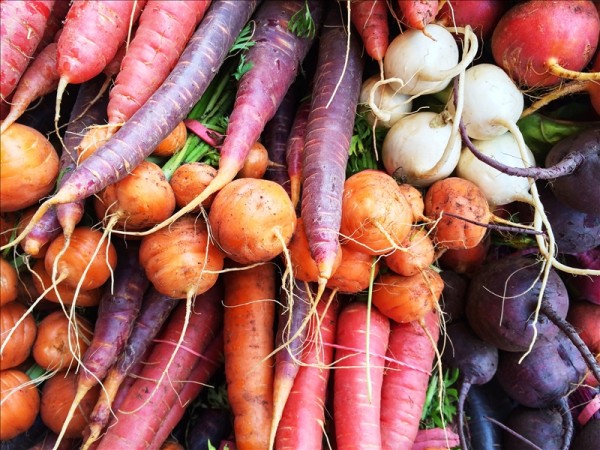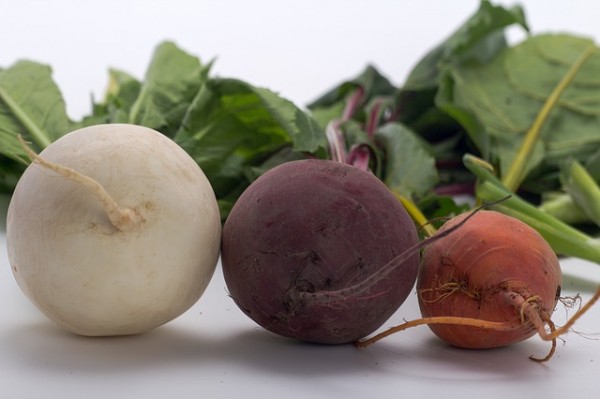Guest post by registered dietitian Dave Seddon, c
Winter may be upon us but we don’t have to miss out on the goodness of fresh vegetables — even in climates where you might think it just can’t be done. That’s according to Eliot Coleman, farmer,
Thanks to increased winter growing by many farmers, including those who provide CSA (Community Supported Agriculture) shares, there are certain locally-grown veggies (and some fruits) available now. And luckily, lots of this produce also stores well.
Here are a few of the Maine-grown vegetables you can find fresh all winter/year long:
Potatoes
Maine is known for its potato crop and potatoes (including their skins) are a source of fiber, potassium and vitamin C.
Look for some out-of-the-ordinary potato varieties, such as the Kennebec or Belrus.
Tomatoes
You might not know this about tomatoes, but in 1893, the Supreme Court was asked to decide if they were a fruit or a vegetable. If they were a vegetable, they were subject to a 10 percent import tax. If a fruit, there was no tax.
The justices ruled that a tomato is a vegetable. They said that from a scientific point of view, they may be a fruit, “but in the common language of the people … they were a vegetable … usually served at dinner in, with, or after the soup, fish, or meats which constitute the principal part of the repast, and not, like fruits generally, as a dessert.”
Studies suggest that higher levels of Vitamin C are found in vine-ripened tomatoes, in comparison to conventionally grown, picked, and commercially ripened (Dumas Y, et. al, 2003). In addition, tomatoes have also been shown to have high levels of lycopene (carotenoids) and flavonoids, substances that are linked to reducing damage caused by free radicals in the body.
Backyard Farms, which grows tomatoes in a 42-acre hydroponic greenhouse in Madison, Maine, is a good example of year-round production. It supplies mainstream supermarkets with vine-ripened tomatoes.
Mushrooms
Foraged mushrooms usually slow down due to snowfall in Maine, but indoor habitats are literally sprouting up all over Maine. This has allowed an explosion of varieties to be seen in local markets — way beyond the domestic button mushroom.
Mushrooms are low in calories and are a good source of B vitamins, a variety of minerals and are one of the few natural, non-animal sources of vitamin D.
Check out some of the products and recipes provided by a few of the growers:
Greens
From large producers like Olivia’s Garden to smaller ones like Little River Flower Farm and Six River Farm, dark to light leafy greens are abundantly available throughout the state. That includes including a variety of lettuces, spinach and chard.
While their nutrient content varies, they all deliver a shot of summer when the tender leaves are tossed into an amazing salad. Add some roasted beets (recipe below) and a few mushrooms to that salad while you’re at it.
Beets
Whether you choose red, orange, yellow, or candy-cane colored, beets are packed with Vitamin C, calcium, potassium, and folate.
In the winter, I’m partial to roasted beets, easily made in the oven. I’m happy to share my recipe with you.
Roasted Beets
Ingredients
- Beets, any and all colors
- Olive oil
- Salt
Instructions
- Preheat oven to 400°
- Place scrubbed, medium-sized beets on a piece of parchment-lined foil.
- Drizzle them with a little olive oil and sprinkle lightly with salt if you like.
- Seal the foil to make a packet.
- Pop the packet of beets in the oven and cook for about 45 minutes.
- Open packet and check if done. If you can easily pierce them with a knife, they are done.
- If they’re not done, return packet to oven for another five minutes and check again.
- When done, remove from oven open packet and let beets cool.
- When cool to the touch, use your hands to rub off the beet skins under light running water.
- Season the beets as desired and eat immediately or keep refrigerated for up to three days.
Where can I find winter vegetables?
Visit a Winter Farmer’s Market to find these and other locally-grown produce. You’ll be supporting local farmers and may discover lots of delicious options for your next meal.
Thanks for reading this guest post from Dave Seddon. He’s a registered dietitian, so he knows what’s good for us to eat! I love beetsand can’t wait to try his recipe. What about you? Do you have a favorite winter vegetable?




I was referred to you by my friend Pinky. I am being severely challenged by a combination of psoriasis and eczema. Hope you have some good advice re food habits etc.have found on line web sites swim to have conflicting advice. Thanks in advance
I will see what I can find out!